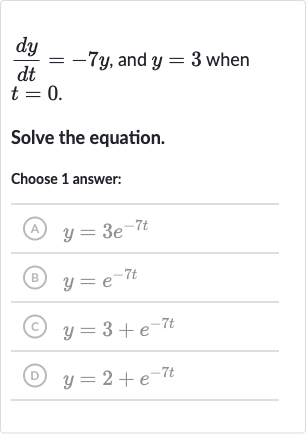Full solution
Q. , and when .Solve the equation.Choose answer:(A) (B) (C) (D)
- Identify Differential Equation: The given differential equation is a first-order linear homogeneous differential equation. To solve it, we can use separation of variables.
- Separate Variables: Separate the variables and by dividing both sides by and multiplying both sides by :
- Integrate Equations: Integrate both sides of the equation:
- Find Constant of Integration: The integral of with respect to is , and the integral of with respect to is . So we have:, where is the constant of integration.
- Apply Initial Condition: To find the constant of integration , we use the initial condition when :
- Finalize Equation: Now we have the equation with the constant :
- Exponentiate to Eliminate Log: To solve for , we exponentiate both sides of the equation to get rid of the natural logarithm:
- Remove Absolute Value: Since for any , we have:
- Final Solution: Since is initially positive ( when ), we can drop the absolute value bars:
- Final Solution: Since is initially positive ( when ), we can drop the absolute value bars: The solution to the differential equation is , which corresponds to answer choice (A).

